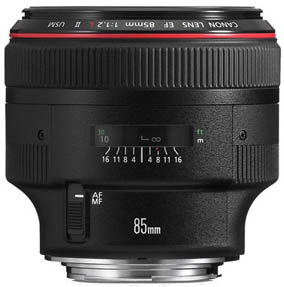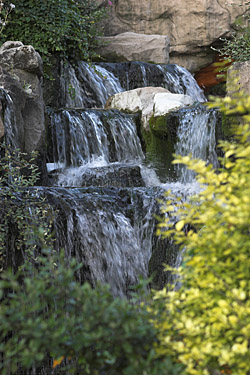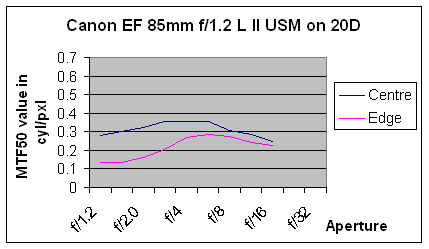Canon EF 85mm f/1.2 L II USM
 Specifications
Specifications
- Focal Length 85mm
- Construction 8/7 elements/groups
- Max Aperture f/1.2
- Min Aperture f/16
- Closest focus 0.95m
- Filter size 72mm
- Hood ES-79 II (Supplied)
- Dimensions 91.5x84mm dia x length
- Weight 1.025kg
- Price £1629
Build and handling
Designed primarily as a portraiture lens that gives an ideal perspective when used on a full frame sensor or 35mm film bodies, the lens can still be used on the cropped sensor bodies of the EOS line-up such as the 1D mk2 (1.3x crop) and the 30D (1.6x crop) giving narrower fields of view. The lens comes supplied in a draw-string leather pouch complete with a dedicated lens hood.
In order to allow such a huge amount of light in, the lens has a large diameter, although it is not abnormally long for the focal length. To make handling easier, especially mounting and dismounting from the camera body, the lens has a cut-away area close to the mount giving the optic a certain unique look to it. Controls are simple, consisting of a single switch to control the AF/MF mechanism and a 15mm rubber ribbed manual focus ring forward of the distance window. The distance window is flush, marked in metres and feet and sports a decent depth-of-field scale that is often omitted in modern lenses.
The manual focus ring extends forward of the rubber ring to incorporate the mounting for the ES-79II supplied lens hood that clips into place and is released by a pair of pinch buttons on the hood. It can be a little disconcerting if, the first time you use the lens, it is set to manual focus and the hood rotates giving the impression that the front element may well be rotating also. Fear not, as the front element, without rotation, operates inside the hood, extending some 13mm on a single trombone to reach the point of closest focus at 0.95m. During autofocus, the MF ring does not rotate although manual over-ride is easily possible with a light touch of the finger.
Canon’s UltraSonic Motor (USM) system of autofocusing has always been quick and quiet but this latest incarnation is virtually silent and almost instant! You may hear it in the reading room of the local library, but even there you would have to listen carefully.
Optical quality
The optical performs of the lens is impressive. By any standards! At the widest apertures it is very good and at f/5.6 it is stunning! And don’t forget that by the time you reach that aperture the lens has already been stopped down by 5 stops!
The control of distortion, as could be expected on a prime lens, is good, measuring just -0.34% pincushion on the Imatest™ distortion module, an amount that is indistinguishable with the mark one eyeball.
The control of chromatic aberration, the bane of digital photography, is probably where the upgrade of this lens has gone the furthest and the figures returned by Imatest™ were in small fractions of a pixel and totally invisible to the naked eye.
As could only be expected with such a huge aperture, flare could be invoked under forced conditions but in general use, no incidences of the phenomenon were recorded. The same can also be said of ghosting where light bounces around inside the lens.
Colour rendition, contrast and resolution are all in the top-drawer category for a lens of this nature with an average resolution figure at f/5.6 of 0.321 cyl/pxl ( MTF50) recorded on the Canon 20D that the test was carried out on.
 |  The amazing control over depth-of-field that this lens offers gives plenty of room for experimentation. F/4 and ISO100 on Canon 20D with a change of focal point was used for both these shots. |
|
Click on each comparision photo below to view full size versions
Below is our lens test data. To find out how to use these graphs look at this article: How we test lenses

Verdict
With this lens’s almost infinitely variable depth of field and its high image quality, along with an ability to suck in light from the dimmest of scenes, it has the capability of making friends fast and keeping them for a long time. As well as the portraiture that it is primarily designed for, the lens is likely to find favour in other disciplines as well, such as indoor sports, Gig and event photographers and anyone wanting to photograph the proverbial ‘black cat in a coal cellar’ too! A specialised lens that is very, nay, exceptionally good at its job.
In summary, the positive points of the Canon EF 85mm f/1.2 L II USM are:
![]() Excellent performance wide open and throughout the aperture range.
Excellent performance wide open and throughout the aperture range.
![]() Whisper quiet and fast AF performance
Whisper quiet and fast AF performance
![]() Huge light gathering ability
Huge light gathering ability
The negative points are:
![]() Hood (although not front element) rotates with MF ring
Hood (although not front element) rotates with MF ring
![]() Price (Although worth it if you have a genuine use)
Price (Although worth it if you have a genuine use)
Check the latest price for the Canon 85mm f/1.2 L II USM here
Discuss this lens and other related lens subjects here
Test by Ian Andrews www.wildaboutkent.com
is my favourite.
http://mypalm.ath.cx/enigma/index.php?topic=810.msg3502;topicseen#msg3502
http://www.lensrentals.com/picture/large/f3skl5uzwcrz.jpg.
The only backdraw that I found is the closest focusing distance of 0.95m. If it could only focus down to 0.5m, this lens would be perfect.
The thing to remember is that the plane of focus on this lens at or near f/1.2 is EXTREMELY shallow. For example, if your subject is about 6.5 feet away, then at f/1.2 the part of the image that will be in focus is .75 inches in front and .75 inches to the back of the subject...a plane of focus that is barely 1.5" (an inch and a half). So if you take a portrait at f/1.2 and focus on the peron's eye, just about any feature that sticks out ahead of the eye and behind the eye will be out of focus (e.g., tip of person's nose). Hope this explains it...
Add your message
Please login here or if you've not registered, you can register here. Registering is safe, quick and free.
photodo Stats
428 MTF tests
74 in-depth photodo reviews
100+ users join each day
Help the lens community by reviewing or rating a lens today via our lens search
Latest Lens Reviews
- Chinon 28mm f/2.8 Vintage Lens Review
- Canon EF 70-200mm f/4L IS II USM Lens Review
- Samyang AF 85mm f/1.4 EF Review
- Sigma 70mm f/2.8 DG Macro Art Review
- Samyang AF 24mm f/2.8 FE Review
- Meike 50mm f/1.7 Review
- Tamron 70-210mm f/4 Di VC USD Review
- Lensbaby Burnside 35mm f/2.8 Review
- Asahi Super Takumar 50mm f/1.4 Review
- Asahi Super-Multi-Coated Takumar 135mm f/3.5 Review



